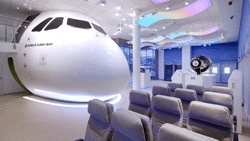Last Friday I had the good fortune to attend the launch of the Emirates Air Line Aviation Experience, a new London attraction designed to educate and entertain those that pass through its doors.
The centre, built at a cost of over £4m, is located next to the Emirates Air Line (aka the London Cable Car) in Greenwich and has been designed to bring thrill of commercial aviation to life.
The 300m2 centre incorporates a full-size scale mock up of the nose of the A380 complete with flight deck, four commercial flight simulators (without motion) including two A380s and two 777 aircraft that can be pre-booked in 30 minute slots, plus a cross-section of a Rolls Royce Trent 800 jet engine partially built with 165,000 pieces of LEGO.
Interactive displays include a virtual wind tunnel application looking at how airflow and air pressure influence flight (I found out the hard way that my idea of the perfect wing will do nothing for fuel economy), a touchscreen game explaining the turnaround process of an aircraft, a wrap-around cinema taking you through Dubai airport’s baggage handling system, and a replica A380 Economy Class seating area with aviation themed videos.
One of the centre’s aims is to get as many school children though its doors to make them aware of the plethora of opportunities made available through aviation, be it as a flight technician, pilot or baggage handler.

Speaking at the launch London mayor Boris Johnson said, ‘It’s fantastically educational, it’ll be inspiring - there’s a lot of engineering and technical stuff that kids will pick up about how flight works and how a jet engine works and so on.
‘It’s also very important to get over to people that this [aviation] is now a massive and growing sector of our economy. The future of our communications and trade is very much going to be in the air - people need to know about it, they need to understand it and they need to support it.’
The event was held for the benefit of the press and, predictably, questions fired at Johnson and Tim Clark, Emirates Airlines president revolved around capacity at London’s airports, a subject addressed today by the Centre for Policy Studies which calls for a so-called ‘Heathrow Hub’.
Putting the current situation into context Clark said, ‘There is a real problem with access to Heathrow. We’ve increased our gauge of aircraft to five A380s a day simply because we can’t get any more slots - and by the way they are 517-seaters and are 90 per cent full. If I want to put any more into Heathrow I really can’t. That isn’t to say that Gatwick isn’t doing a job for us because that is a very important airfield but, taken together, the South East — and London in particular — needs more airfield capacity, needs more runway capacity.
Johnson believes a four-runway solution is required to win back routes going to the Far East and Latin America that have been lost to Schiphol in the Netherlands, Frankfurt in Germany, Charles de Gaulle in France and other European rivals.
‘The best solution that my guys have identified so far is the Isle of Grain site. That brings enormous regeneration benefits,’ he told assembled journalists. ‘If you combine that site through the Lower Thames Crossing, which the government is now consulting on…you’ll have an amazing concentration of logistics power in the east of London.’
The Centre for Policy Studies, however, has identified a way to keep Heathrow operating in a way that would double the airport’s capacity and improve transport links.
The Heathrow Hub would be an integrated air and rail facility with direct links to the M25, Crossrail, Great Western Main Line, and an alternative HS2 route via the airport.
It suggests extending both existing runways at Heathrow up to a total length of about 7,000 metres, then dividing them so that they each provide two, full-length runways, allowing simultaneous take-offs and landings. This, they claim, will decrease the impact of noise as the airport’s opening times would be reduced.
Commenting in today’s City AM, Mark Bostok, a director of Runway Innovations and Heathrow Hub said, ‘A significant increase in available runway capacity could also allow for runway alternation at different times of the day to provide noise relief, and would be compatible with innovative noise reduction techniques like quieter approaches and steeper climb-outs. And few (if any) new areas will be brought into the airport’s noise footprint.’
The youngsters who do take inspiration from the Emirates Air Line Aviation Experience could eventually find themselves working in any number of locations around the world. It might even be in Britain, once a coherent and unequivocal decision has been made about the future of civil aviation in the South East.
More information on Heathrow Hub can be found here. Anyone wanting to book a flight on the Emirates A380 or 777 simulators should click here.











UK Enters ‘Golden Age of Nuclear’
The delay (nearly 8 years) in getting approval for the Rolls-Royce SMR is most worrying. Signifies a torpid and expensive system that is quite onerous...